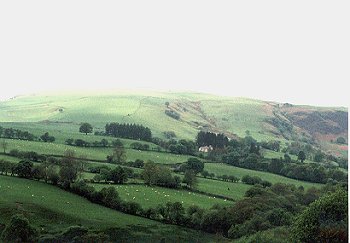
Cymraeg / English

|
Tanat Valley Historic Landscape |

|
Character area map |
Historic Landscape Characterisation
The Tanat Valley:
Y Clogydd, Llangynog and Llanrhaeadr-ym-mochnant, Powys
(HLCA 1017)
Extensive area of 19th-century enclosure of common land with sheepfolds and metal mining remains on southern edge of Berwyns.

Historic background
Early activity is represented by prehistoric funerary and ritual sites. The area fell within the medieval parishes of Pennant Melangell, Llangynog and Llanrhaeadr-y-mochant and fell administratively within the commote of Mochnant Uwch Rhaeadr.
Key historic landscape characteristics
Hillside land on southern edge of Berwyns, between a height of about 300-600m OD, with more gentle slopes to the east and with steeper slopes into the valley of the Afon Tanat with crags and screes at Garnedd Wen, Glan-hafon and Y Garn on the south, and steeper slopes into the valley of Afon Rhiwarth on the north-east with crags at Craig Garwallt and Craig-y-mwyn. Extensive boggy areas.
The gentler slopes are predominantly improved and semi-improved pasture and rough grazing with bracken, gorse, low trees and shrubs on boulder strewn steeper slopes. Large straight-sided enclosures, often irregularly triangular or polygonal in shape largely defined by post and wire fences with some abandoned fields with grown out hedges on lower slopes. Occasional low dilapidated drystone walls. Large, scattered modern clearance cairns. Some high up boundaries show lynchet formation indicating former ploughing. Drystone sheepfolds around the margins of the area and more scattered ones higher up the hill. Small conifer plantations.
The hill is criss-crossed by footpaths and tracks linking isolated communities at the heads of Cwm Rhiwarth and Cwm Blowty and providing access for upland grazing for the farms which skirt the lower fringes of the hill.
There are extensive and important remains primarily of lead mining at Craig-y-mwyn at the head of Cwm Blowty, Mwnglawdd Cwm-orog, and on a lesser scale in Cwm Glan-hafon, to the east of Craig Rhiwarth. The visible remains are primarily of 18th- to 19th-century in date, but there are suggestions of medieval or possibly earlier mining in some cases. Workings at Cwm-orog and Craig-y-mwyn probably began during the late 17th-century, continuing intermittently with varying fortune during the 18th and 19th-centuries, backed initially by the Herbert's of Powis Castle and the Middletons of Chirk Castle and subsequently by outside capital, Craig-y-mwyn becoming involved in scandal between the 1850s and 1880s when it was alleged that mine leases were sold at a huge profit on the basis of grossly misleading information. Production had mostly ceased by the end of the 19th century, though the arrival of the Tanat Valley Light Railway was partly responsible for a small-scale revival in the fortunes of the mining industry up to about 1911, a total of 42 people being employed at Cwm-orog in 1908 for example. At Craig-y-mwyn are extensive mining remains including leats, dams and hushing earthworks above the main opencast, linear trial trenches, levels and shafts, tramways, inclines and evidence of dressing floors, the remains of an incline winding house and crusher house, and the remains of miners' cottages, a powder magazine and a small mine office and workshop or smithy, trackways and boundary stones. Similar remains are present at Cwm-orog, also including ore-chutes and bins. This mine is unique in Wales in showing a sequence of three sucessive systems of transporting the ore to the foot of the hill - contour tramways connecting to long oreslides, being superseded firstly by an incline tramway and later by an aerial ropeway. Small-scale mining remains in Cwm Glan-hafon, the hanging valley to the east of Craig Rhiwarth, and also said to include evidence of later 16th- to 18th-century smelting.
Sources
Jones & Frost 1995Walters 1993
Williams 1985
Wren 1968
For further information please contact the Clwyd-Powys Archaeological Trust at this address, or link to the Countryside Council for Wales' web site at www.ccw.gov.uk.
Privacy and cookies